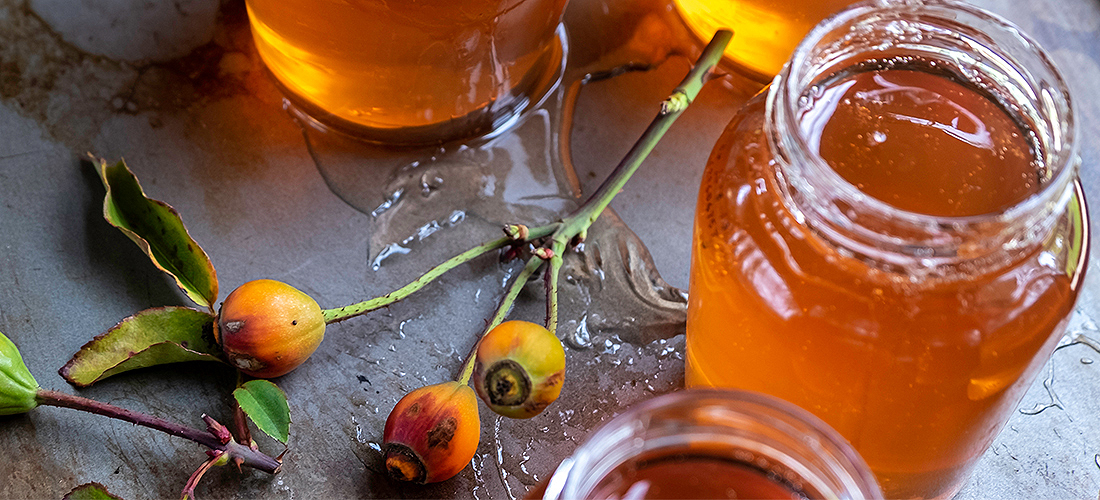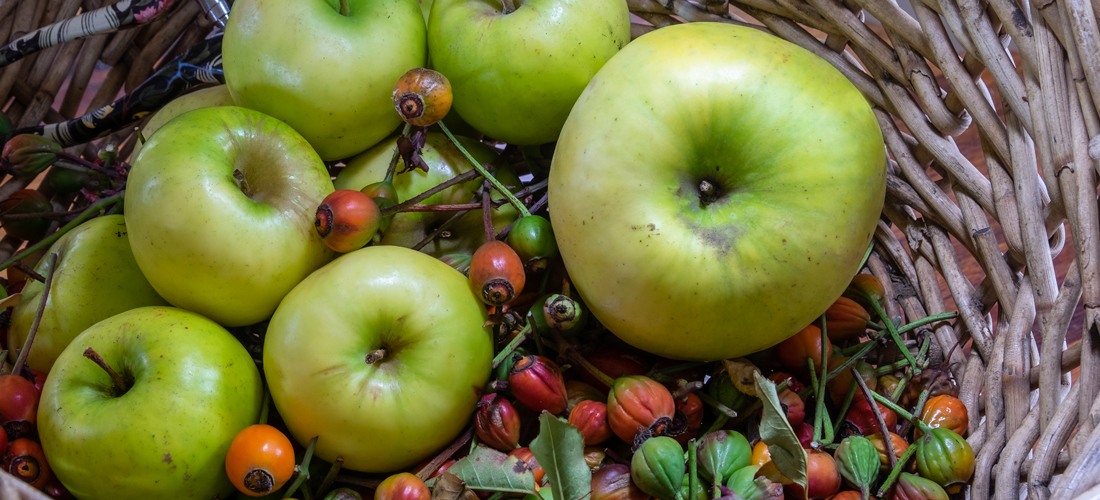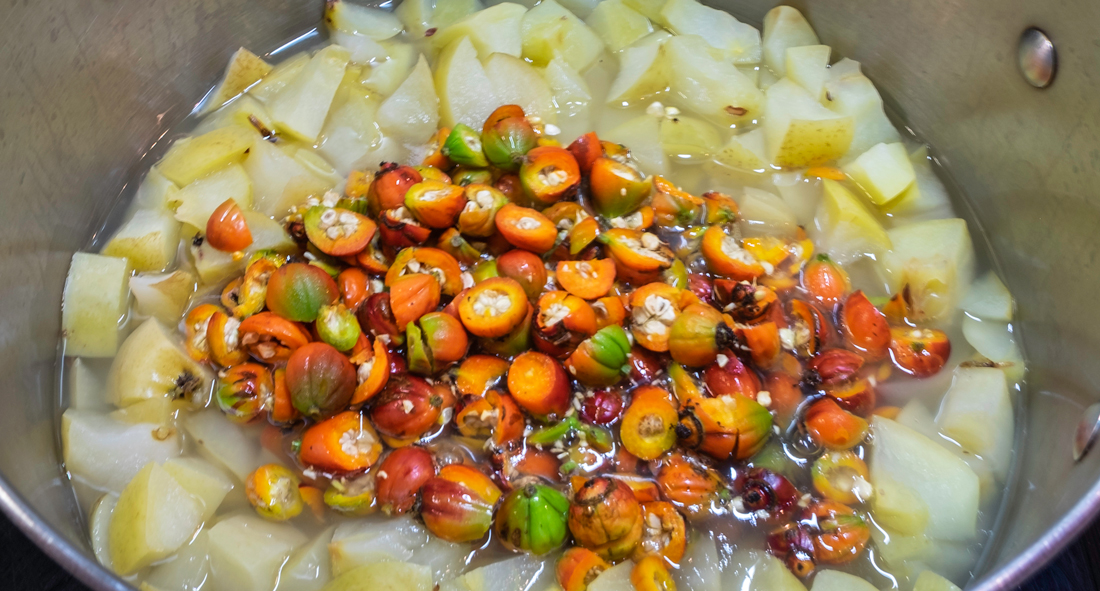Rosehip and Apple Jelly
- Jams, Jellies & Marmalades

Rosehip jelly is a star, served either as a sweet spread or as an accompaniment to white meats. Foraging for wild rosehips or collecting them from the garden is an autumn and winter treat. As it glistens, it reminds me of the wonder and power of nature: providing food in so many different forms. Jellies might take a little longer to make than jam, but the wait is well worth it. A perfect autumn preserve when apples and rosehips are in abundance.
- Preparation Time:
- 20 minutes + draining overnight
- Cooking Time:
- 50 minutes
- Quantity:
- 5 x 300 ml jars
INGREDIENTS
- 1 kg
- Apples, Granny Smith or other cooking apple
- 450g
- Rosehips, ripe
- 1.3 kg
- Sugar, white

METHOD
Jellies are made from the strained juice of simmered fruit. The juice is then boiled with sugar until the setting point is reached. The juice is measured to calculate the amount of sugar required.
A perfectly set jelly should quiver when spooned out of the jar.
Wash the apples to remove any garden or shop debris. Wash the rosehips and remove the ends. Remove any bruised or damaged fruit.
Leaving the skin on, cut the apples into quarters, then cut each quarter into half or thirds depending on the size of the apple. Roughly chop the rosehips. Place the apples and rose hips including the core and seeds into a preserving pan or large heavy-based stainless-steel pot.
Add water, just enough to cover, then add an additional 300 ml of extra water. Bring the fruit mixture to the boil, then simmer gently uncovered until the apples are very soft and pulpy.
Remove from the heat and allow to stand for approximately 10 minutes to draw out additional colour and flavour from the rosehips.
Scald the jelly bag with boiling water and set up jelly bag over a glass or plastic bowl. Refer Notes section below .
Ladle the fruit mixture and liquid into a jelly bag. Allow to drain naturally overnight and do not try and force the liquid through. This will result in a cloudy liquid and make a cloudy jelly.
The next day. Measure the drained liquid and allow an equal quantity of sugar. For instance, if you have 600ml liquid allow 600gm sugar.
Place the strained apple and rosehip liquid into a preserving pan and bring to the boil. Add warmed sugar and stir until completely dissolved. Then bring to boil quickly and boil for approximately 20 minutes or until the jelly reaches setting point.
Remove the scum, foam like substance which rises to the surface. Remove from the heat.
Using a funnel to pour into warm dry sterilised screw cap sealable bottles, fill to approximately 2.5cm (1 inch) from the top of the bottle and seal. To remove any air bubbles, gently tap the jars once they have been filled.
-
Label and store in a cool dark place in the kitchen or pantry.
Allow the jam to mature for at least 2 weeks before eating.
NOTES

- Rosehips are the rose fruit. Once the rose has finished flowering and dropped its petals, the fruit grows. When ripe they are are an orange-red colour. Rosehips can be collected from wild or domesticated garden roses. This Rose Hip article provides a good overview is you're looking for some more information on its cultural and medicinal background.
- Choose ripe clean fruit. Do not use overripe and never use mouldy fruit as this will produce a poor-quality jelly.
- The sugar quantity in the recipe (1.3 kg) is an approximation only. The quantity required will depend on the volume of juice obtained through the jelly bag, after it has been left to drain.
- To warm the sugar, put the recipe quantity in an oven proof container and place in a preheated oven to 150 degrees C for approximately 10 minutes. The sugar should be warm throughout the bowl. Warmed sugar, dissolves quickly and a rapid boil until the setting point is reached helps to preserve the fresh fruit flavour.
- Allow the juice to drain naturally through the jelly bag overnight. Do not push down or try to force the liquid out of the fruit pulp at this stage. This produces a cloudy jelly. A good quality jelly should be clear and sparkle with clarity.
- The Jelly Bag.
- A jelly bag is essential to make jelly. It can be made from heavy-duty calico, cotton flannel or close-weave nylon, multiple layers of muslin (cheesecloth) or any other material that will only allow the fruit juice to flow through. They are also commercially available through good homeware and speciliaty preserving stores.
- Secure the jelly bag tightly, using loops or very strong tape, on an upturned stool or chair, in a jelly bag holder or over a stainless-steel sieve. Place a bowl underneath to catch the juice as it strains.
- Fill the jelly bag progressively with the cooked fruit mixture and all of the cooking liquid. The skin, seeds, pulp and liquid must strain through the bag. Leave to drain overnight.
- Do not squeeze the bag to extract juice as this will create a cloudy jelly.
- Immediately after use, remove the pulp and seeds, thoroughly wash the jelly bag, and rinse several times to remove all traces of detergent. Completely dry the bag before storing. The bag can be reused multiple times, however, sterilise it before every use.
- Prior to each use scald with boiling water. This will also help the juice to run freely through the bag, instead of being absorbed into it.
- Jelly yield is lower than jam as the pulp is discarded. The final yield will depend upon how juicy the fruit is, and this is influenced by the fruit’s ripeness and time of year.
- Removing the scum
- Jams, jellies, and marmalades can produce a scum while they are boiling. Impurities from the fruit and sugar will rise to the surface and a fine frothy foam will move towards the edge of the preserving pan.
- Some fruits will produce more scum than others. This is a natural self-clarification process and makes the task of making a high-quality preserve easier.
- Removing the scum increases the preserve’s clarity. This is very important if it is being submitted for competition.
- Remove the scum before bottling. Using a stainless-steel spoon, skim the scum from around the edge of the preserving pan. Be careful to remove just the scum and not the jelly. This can be done while the preserve is boiling and/or once it has been taken off the heat.
- Do not attempt to remove the scum from the centre of a boiling pan, as there is a high risk it will splutter and hot preserve burns.
